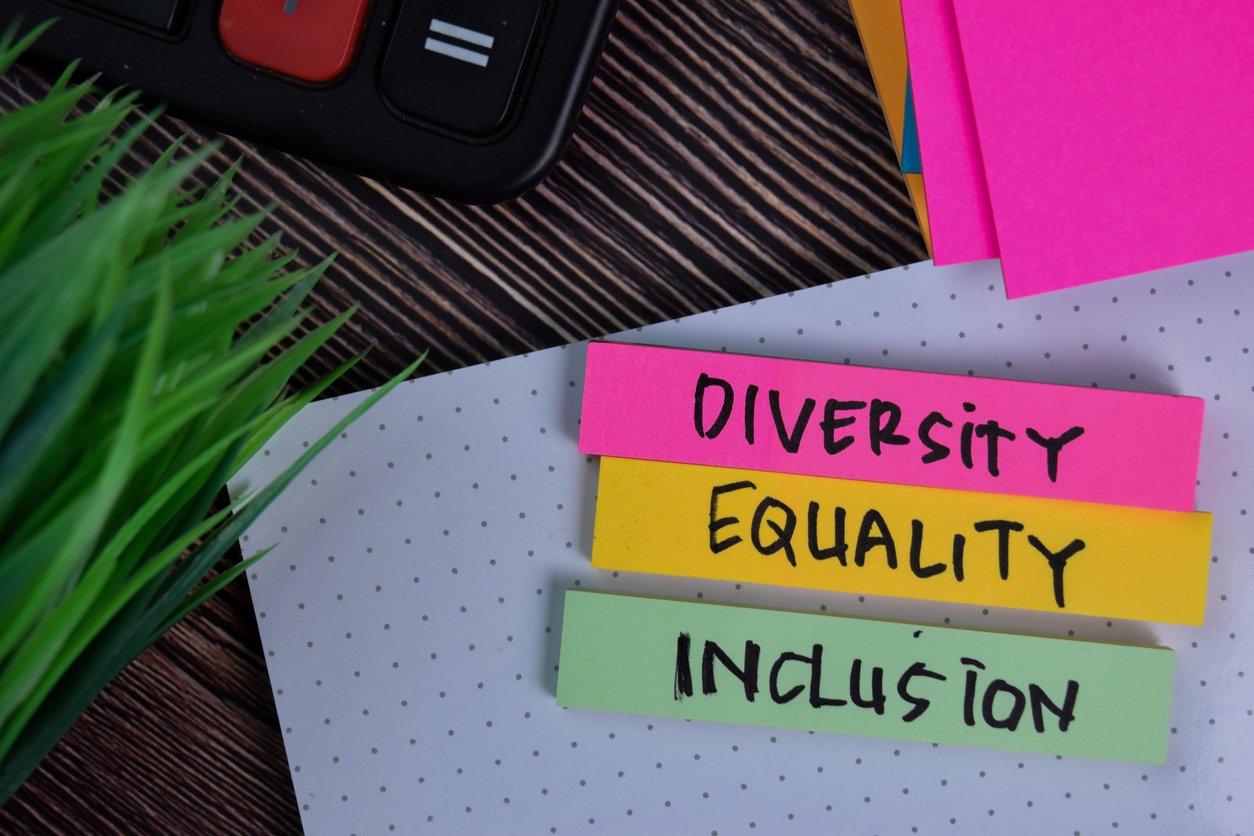Becoming menopause friendly means changing the way you think about menopause at work. Starting conversations, shifting mindsets and really embedding support at every turn. Here, Kerry Kirk, D&I Lead at the Employers Network for Equality & Inclusion (enei) explains the role of equality, diversity and inclusion in your menopause friendly plans.
What are the definitions of equality, diversity and inclusion?
It’s important to be clear about these, as they don’t mean the same thing.
Equality is about equal opportunity and fairness in the workplace for employees and applicants.
Diversity means the range of people in your workforce, which should replicate the range of people in society. It should mean there are workplaces made up of people of varying ages, religions, ethnicities, beliefs, gender identities and so on. But to benefit from that truly inclusive culture it’s important that these differences are valued, and diversity not just seen as a box-ticking exercise.
Inclusion means representation. Without inclusion, the crucial connections that attract diverse talent, encourage their participation, foster innovation and lead to business growth won’t happen. An inclusive workplace is somewhere that employees feel valued, able to contribute and to bring their authentic selves to work. They belong! When people feel safe and that they belong they experience greater meaning, satisfaction and stability in the workplace. As a result, they are more productive.
The case for equality, diversity and inclusion
There’s a very compelling moral business case for equality, diversity and inclusion (EDI) in the workplace and beyond. This means ensuring that everyone is treated equally, fairly, with dignity and respect.
In terms of the legal case there is legislation including the Equality Act 2010. This applies across England Scotland Wales and, in part, Northern Ireland. This identifies the nine protected characteristics.
Then there’s the business case. There is significant evidence of diverse and inclusive organisations outperforming their peers. We’ve seen great changes in terms of the world of work over past few years. Many more people are working from home. And ‘the great resignation‘ has impacted a number of organisations. So businesses need to think carefully about how to attract and retain talent.
A journey, not a destination
Progressive employers have for some time been integrating equality and inclusion initiatives and activities into their core business functions. These organisations typically treat inclusion as a journey rather than an end point or a specific destination. In part, because of continuing changes in the environment they operate in. Things like their employee profile and how that compares with the demographics of the area. That changes over time and will tell an organisation how inclusive or representative their workforce is.
Another area where we constantly see change is around working practices. For example, working from home or a more hybrid model. Menopause is another example of changing practices in the workplace. Not that long ago it would have been a taboo subject and just wouldn’t have been considered let alone discussed at work.
Case law and legislation also continues to evolve and develop. Recently, menopause has featured in employment tribunal claims, showing the changing expectations in terms of the world of work.
Plus, we absolutely wouldn’t have expected ten years ago that menopause would have become the subject of a government inquiry into the extent of the discrimination faced by menopausal people in the workplace and considering how government policy could better support and address those issues.
Protected characteristics
I mentioned the nine protected characteristics earlier. These are age, disability, gender reassignment, marriage and civil partnership, pregnancy and maternity, race, religion or belief, sex, and sexual orientation.
Most people have around three they identify with. So it’s important that we don’t view them in isolation or as single issues. There can be many connections between those characteristics and its those connections and characteristics that make up our own unique identities.
If we use menopause as an example. Typically there are two characteristics front of mind – gender and age. However, in some cases the effects of menopause could be considered as a disability where there’s a long-term impact. And it can also affect far more than simply cis females of a particular age.
Some people go through the menopause far earlier than the average age. Trans men – those who identify as male but were assigned female at birth – could experience menopause. If you take a broader view then really everyone and anyone could be affected by menopause in varying degrees. Either directly as someone who’s gone through menopause or indirectly as partner, friend, colleague, carer, family member.
A broader approach to inclusion
There’s a lot to consider in your diversity and inclusion practices and how workplaces can become more inclusive. Here are some key points to consider:
Senior buy in
You need to think about various things. But one of the most important is securing buy in and sponsorship from the top of your organisation. Those people will be your biggest allies or potentially your biggest challengers. If it’s not prioritised at the top then it will be harder to integrate an inclusive culture across the business.
When you have buy in, consider what kind of vehicle or taskforce you will need progress change. Who are the key stakeholders and players that you would want to help bring that culture of inclusivity to life?
Ensure that any such group is representative, in terms of functions, level of position, or if you have different locations, then also representing them.
Core values
If your core values don’t already include some kind of statement about your approach to equality, diversity and inclusion then you need to consider this. Inclusivity should be part of everything you do and reflected in how you operate on a day-to-day basis.
Accessibility
You should also consider how accessible your organisation is, from a physical perspective to your online presence.
Words and images
The language you use, verbally and in any communication, should be as inclusive as possible, avoiding gendered terms. And think about the imagery you use and the message that it sends – is it inclusive?
Consider pronouns
You could start using pronouns in your email signature to make it clearer how you’d like to be referred to in conversations. This can also help with normalising workplace discussion around gender. But I wouldn’t recommend making the use of pronouns mandatory – there may be some who are not ready to share their identity more publicly.
Look at the terminology you use
For example, there is government guidance on writing about ethnicity, not using BAME or BME but being more specific rather than grouping people together. You can even find things like gender decoder that you can run job descriptions and adverts through which will tell you if the text has a gender bias, to help you use language which is more appealing regardless of how someone identifies.
Make the most of any one-to-one conversations
These are opportunities not just to catch up on to-do lists but to build trust. This is key to encouraging open dialogue, allowing employees to honestly express their needs or discuss any challenges, particularly those of a sensitive nature.
Listen to everyone
There will be people on your team who have louder voices and those who are more introverted. Think about how you might encourage introverts to participate so that you’re not hearing simply from those who have the loudest voices.
Foster company-wide links
Employees are likely to have fairly strong relationships with their immediate colleagues, but how well do they know others? Encourage a culture of workplace inclusivity by creating opportunities across teams and locations to mix and have conversations in formal or informal settings. That can help us learn about each other and start being able to better embrace differences.
Widen your recognition and rewards
In terms of recognition and reward, it’s helpful to consider the types of behaviours that the organisation rewards and the signal that could send to others about the skills, talents and commitment that your organisation values. Does that align to your core values? If not then I’d suggest making changes.
You might also want to think about some of the less visible contributions. So it’s not always about the top salesperson, for example. But also the things that go on in the background that help your company and employees flourish.
Consider your work events and initiatives
Think about how you use these to raise awareness and celebrate inclusion. You can find notable dates or religious festival information online, for example, with resources to help you celebrate or deliver awareness training around these dates or events.
You might also want to think about other events you’re organising. Who are you inviting to those events? Which charitable causes does the company support? Consider these from a diversity and representation perspective, providing further opportunity to foster team building and raise morale as you actively celebrate that inclusive workplace culture.
My top six tips from an individual perspective are:
- Talk about inclusion and what that means for you and others, engaging and sharing and understanding different perspectives
- Join a staff network, not necessarily one you identify with. You could become a supporter or ally of others to improve your understanding of their challenges at work and how you can better support them.
- Become a mentor or mentee. Again a great way to make new connections to share experiences that benefit both parties, as well as your team environment and individual development.
- Make sure all colleagues can participate regularly in team meetings and events. Think about how you can ensure all colleagues can take part regularly and actively in team meetings and events. If you’re thinking about social events, remember there will be particular activities or sports part of the group are interested in and others aren’t, so consider those that are more inclusive or putting on a range of events.
- Speak up if you see behaviours that would exclude colleagues. Be reflective and receptive to feedback about your own behaviour.
- Encourage individuals to participate in regular engagement surveys. And, the higher response rate, the more accurate and better informed the outputs enabling leaders take an evidence-based approach to improving inclusion at work.
We have made some great progress in terms of equality, diversity and inclusion. But there is still work to be done. Considering it in every aspect of your organisation can really help you as you journey towards becoming menopause friendly.
Written in partnership with Menopause Friendly and Kerry Kirk, D&I Lead at the Employers Network for Equality & Inclusion (enei) the UK’s leading employer network covering all aspects of equality and inclusion in the workplace.





Comments are closed